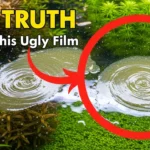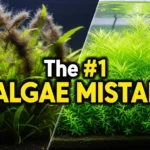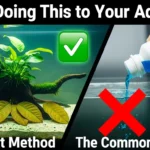If you’ve been testing your aquarium water, you’ve likely come across the term “nitrates.” You see a number on your test strip, and a quick search online tells you that high nitrates are “bad.” This often leads to a cycle of endless water changes, a reliance on expensive chemical products, and a constant feeling of stress, wondering if you’re doing enough to keep your fish safe.
I’m here to tell you there is a better way. After years of building beautiful, stable ecosystems, I’ve learned that the most common advice on how to reduce nitrates in your aquarium often misses the single most powerful tool we have at our disposal. It’s not about more work or more chemicals; it’s about creating a smarter, more natural system.
Today, we’re going to explore the definitive, long-term solution to high nitrates. We will learn how to stop fighting nitrates and start using them to create a healthier, more beautiful, and far more stable low-tech planted tank.
What Are Nitrates and Why Do They Matter?
Before we can control nitrates, we need to understand what they are in plain English. Nitrates (NO₃) are the final byproduct of the nitrogen cycle in your aquarium.
- Your fish produce waste (ammonia).
- Beneficial bacteria convert that toxic ammonia into another toxic compound, nitrite.
- A second type of bacteria converts that nitrite into the much less harmful nitrate.
In a fish-only tank, these nitrates have nowhere to go. They simply build up in the water over time. While nitrates are far less toxic than ammonia or nitrite, at very high levels (typically over 40-50 ppm), they can cause stress to your fish, stunt their growth, and become a major fuel source for stubborn algae blooms. This is why the standard advice is to remove them through constant water changes.
But in a planted tank, nitrates aren’t a waste product. They are a free, high-quality fertilizer.
The #1 Method: Turning Nitrates into Growth with Live Plants
This is the secret that will change the way you manage your aquarium forever. The single best way to how to reduce nitrates in your aquarium is to add plants that will eagerly consume them.
Here’s the simple biology: Plants, just like plants in your garden, require nitrogen to grow. It’s a fundamental building block for them to create proteins and new leafy tissue. To a plant, the nitrate in your water column is a delicious, five-star meal. They will actively pull it out of the water through their leaves and roots, using it as fuel for new growth.
By heavily planting your tank, you are essentially creating a beautiful, living, self-regulating filter. The more your plants grow, the more nitrates they consume. A fast-growing, healthy plant is a nitrate-removing machine. This creates a virtuous cycle: fish produce waste, bacteria convert it to nitrates, and plants consume the nitrates to grow, which in turn keeps the water clean and safe for the fish.
Our Top 5 “Nitrate-Sponging” Plants for a Low-Tech Tank
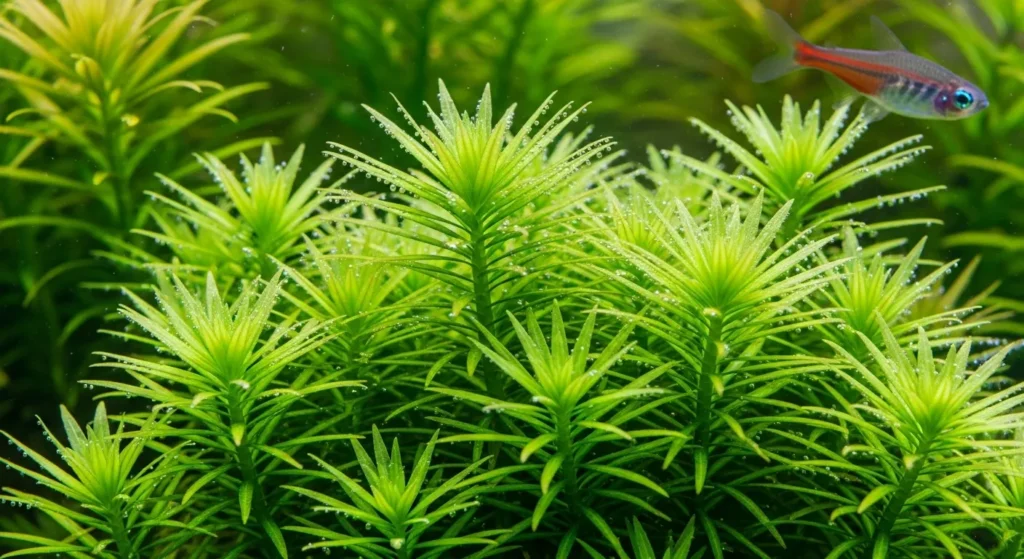
To maximize this effect, you want to include plants that are known for being fast-growing and hungry. These are your nitrate-sponging superstars.
- Hornwort (Ceratophyllum demersum): This is perhaps the most effective nitrate-remover on the list. It grows incredibly fast, either planted or floating, and will absorb huge amounts of nitrates from the water.
- Anacharis (Egeria densa): Another classic, fast-growing stem plant. Anacharis is incredibly hardy and will thrive in almost any low-tech setup, constantly pulling nutrients from the water.
- Guppy Grass (Najas guadalupensis): This plant is aptly named as it grows into a dense, bushy mass that provides amazing cover for fish and shrimp fry. It’s a fantastic nitrate consumer that requires virtually no care.
- Pearl Weed (Hemianthus glomeratus): A versatile plant that can be used as a background stem plant or even trimmed to form a carpet. It’s a fast grower that will actively help keep your water parameters pristine.
- Vallisneria (Jungle Val): For larger tanks, nothing beats Jungle Val. These long, ribbon-like plants send out runners and can quickly create a dense, beautiful background forest, consuming nitrates the entire time.
Also Read: The Nitrogen Cycle in a Low-Tech Aquarium: Your #1 Stress-Free Guide
Method 2: The Role of Proper Water Changes
Now, does this mean you never have to do a water change again? Not quite. Water changes are still a vital part of aquarium maintenance, but their primary role shifts in a well-planted tank.
Instead of being your only tool for nitrate removal, water changes become a way to “reset” the system and replenish essential minerals. While your plants are consuming nitrates, they are also using up trace elements and minerals in the water that are vital for their health and the health of your fish and invertebrates.
A regular, 20-30% weekly water change helps to remove any excess organic buildup and, more importantly, replenishes these essential minerals, ensuring the long-term stability of your ecosystem. Think of it less as “removing bad stuff” and more as “adding good stuff back in.” This is a key part of learning how to reduce nitrates in your aquarium for the long haul.
Method 3: Floating Plants – The Secret Nitrate Killers
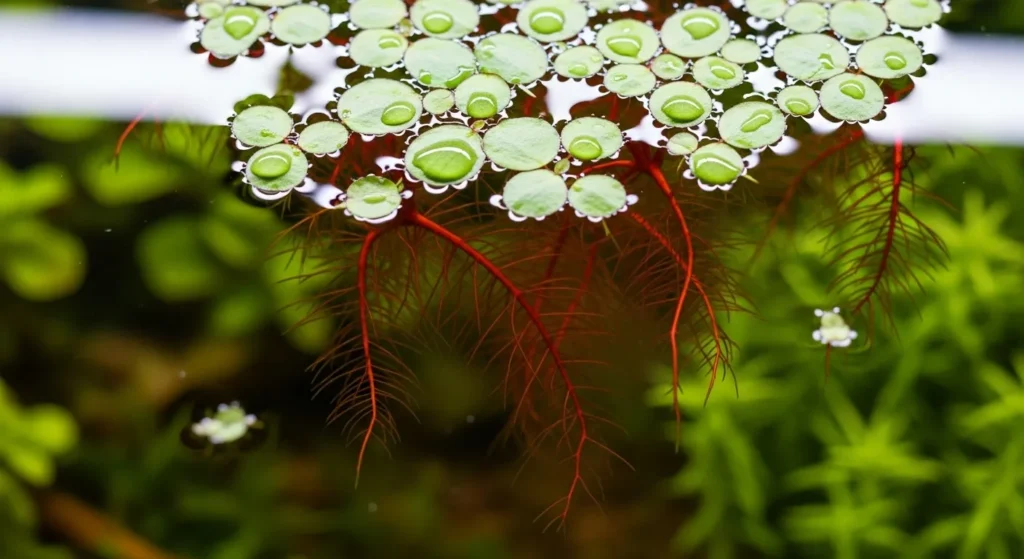
If you want to supercharge your natural nitrate removal, look no further than the surface of your water. Floating plants are one of the most powerful, yet underutilized, tools in the hobby.
Why are they so effective? Because they have unlimited access to the two things plants need most: light (they’re right at the top) and CO2 (from the open air). This allows them to grow at an explosive rate, and to fuel that growth, they pull massive amounts of nitrates directly from your water column through their dangling roots.
Excellent Floating Plants for Nitrate Control:
- Water Spangles (Salvinia minima): An attractive, fast-spreading floater with small, fuzzy leaves.
- Dwarf Water Lettuce (Pistia stratiotes): Looks like tiny heads of lettuce floating on the surface.
- Red Root Floaters (Phyllanthus fluitans): A beautiful plant that develops deep red roots and leaves under good lighting.
Adding a small patch of floating plants is like installing a high-powered, all-natural nitrate filter on your tank. You simply remove a handful every week or two as they grow, and in doing so, you are physically removing the nitrates they have consumed.
Do You Need Chemical Nitrate Removers? (The Honest Answer)
When you walk into a pet store, you’ll see a variety of filter media, resins, and pads all promising to remove nitrates from your water. Do you need them?
For a well-balanced, properly stocked low-tech planted tank, the answer is almost always no.
These products are a solution to a problem that you can solve for free using natural methods. They are a crutch, not a cure. By investing in a healthy population of live plants, you are building a permanent, self-sustaining system for nitrate control. Chemical removers are a temporary fix that requires constant replacement and expense.
Focus on building a healthy ecosystem first. Use plants as your primary filter. Perform regular, sensible water changes. If you do these things, you will likely never have a nitrate problem that would require a chemical solution. Learning how to reduce nitrates in your aquarium naturally is far more rewarding.
Testing and Understanding Nitrate Levels
To know how your system is performing, you need to test your water. A liquid test kit is far more accurate than paper strips. When you test, what is a “safe” number?
- In a Fish-Only Tank: The goal is to keep nitrates as low as possible, ideally under 20 ppm.
- In a Low-Tech Planted Tank: The perspective changes. A reading of 10-20 ppm is actually a good sign. It means there is enough food in the water to keep your plants healthy and growing. If your nitrates are consistently at 0 ppm and your plants look pale or are growing poorly, it might actually be a sign that they’ve run out of food and you may need to add a comprehensive fertilizer.
The ultimate goal is not zero nitrates, but a stable, low-to-moderate level of nitrates that indicates a balance between the waste being produced and the nutrients being consumed by your plants. This is the hallmark of a truly successful planted tank and the best way to how to reduce nitrates in your aquarium long-term.

Daniel Ravera is the founder of AquaInitium, where he shares insights gained from over a decade of hands-on aquascaping. His expertise lies in the low-tech, ecosystem-first method—a philosophy he adopted after experiencing the common frustrations of algae and instability himself. As an authority in the beginner aquascaping niche, Daniel provides clear, trustworthy advice to help you build a beautiful, stable aquarium and avoid the costly mistakes he learned the hard way.




